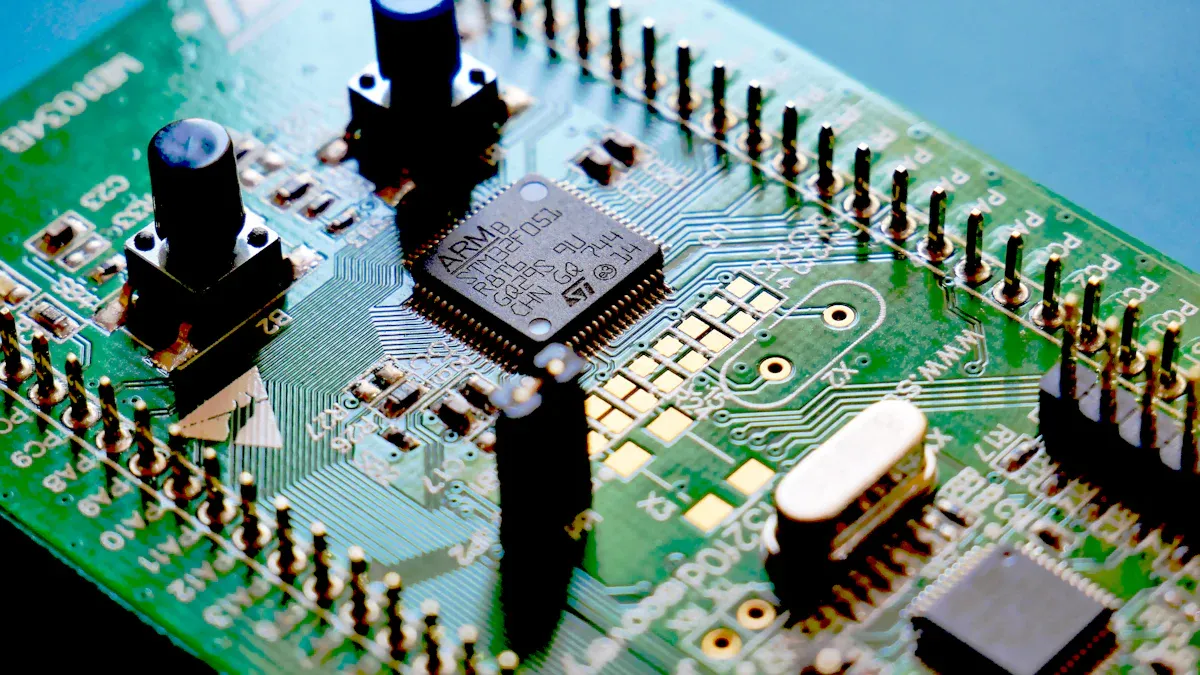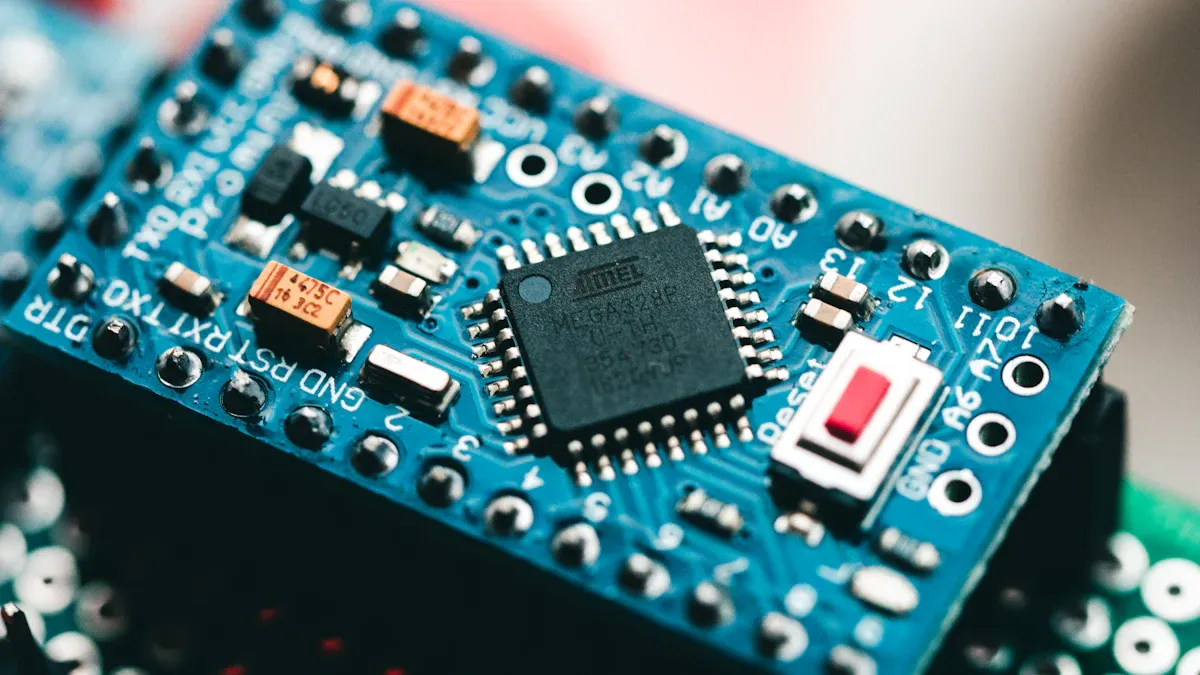What Are IC Voice Processors and How Do They Work

IC voice processors play a crucial role in modern technology by managing audio signals. These integrated circuits detect, decode, and process both analog and digital sound, enabling features like voice recognition, synthesis, and noise cancellation. You encounter these processors in devices that rely on voice control, such as smart speakers and communication systems.
The demand for IC voice processors has surged globally.
The market is projected to reach 15.82 billion USD by 2024.
By 2032, its valuation is expected to rise to 25.25 billion USD.
A growth rate of 6.02% annually highlights their increasing adoption.
These processors continue to enhance audio experiences across industries, making them indispensable in consumer electronics and beyond.
Key Takeaways
IC voice processors improve sound by handling analog and digital signals.
They allow features like recognizing voices and reducing background noise.
The market for these processors is growing fast, reaching $25.25 billion by 2032.
This shows how important they are becoming in modern technology.
These processors are used in electronics, healthcare, and cars to work better.
Features like cutting noise and clearer speech help in loud places.
When picking devices, choose ones with advanced voice processing features.
What Are IC Voice Processors?

Definition and Core Features
An IC voice processor is an integrated circuit designed to handle audio signals with precision. It processes both analog and digital sound, enabling advanced functionalities like voice recognition, noise cancellation, and speech synthesis. These processors rely on artificial intelligence and natural language processing to achieve human-like accuracy and contextual awareness.
Key features include:
Continuous learning and real-time adaptation to improve performance.
Enhanced speech intelligibility in noisy environments, as demonstrated by the eVoice technique, which provides a 2.2-dB SRT benefit in stationary noise.
Significant improvements in consonant recognition, with up to 18% better performance in affricate and back-in-place sounds compared to less advanced systems.
Feature | Good Group (CI+HA) | Poor Group (CI+HA) |
|---|---|---|
Consonant Recognition (Affricate) | 15% - 18% improvement | < 5% improvement |
Consonant Recognition (Back in Place) | 10% - 18% improvement | < 5% improvement |
HA Alone Transmission Range | 20% - 40% | Lower than good group |
These features make IC voice processors indispensable for devices requiring high-quality audio processing.
Key Components of IC Voice Processors
IC voice processors consist of several critical components that work together to deliver seamless audio processing:
Digital Signal Processor (DSP): Handles complex algorithms for speech recognition and noise reduction.
Analog-to-Digital Converter (ADC): Converts analog sound waves into digital signals for processing.
Microcontroller Unit (MCU): Manages the overall operation and integration with other systems.
Memory Units: Store data and algorithms for real-time processing and adaptation.
These components enable IC voice processors to deliver enhanced sound clarity and performance, even in challenging listening environments. Their ability to adapt and learn ensures continuous improvement in user experience.
Importance in Modern Technology
IC voice processors are at the heart of many technological advancements. They play a crucial role in improving hearing ability, usability, and satisfaction in real-world environments. For example, the Nucleus 7 SP has demonstrated superior speech recognition compared to older sound processors, highlighting the importance of these circuits in auditory technology.
Evidence Type | Description |
|---|---|
Real-world Benefits | Improved hearing ability, usability, and satisfaction in real-world environments. |
Speech Recognition | Superior performance compared to older sound processors. |
Technological Evolution | Advancements in cochlear implant technology over the last 30 years reflect collaboration among engineers, surgeons, and audiologists. |
IC voice processors also drive innovation in consumer electronics, IoT devices, and wireless audio systems. Their integration with artificial intelligence ensures smarter, more efficient devices. As technology evolves, these processors will continue to shape the future of human-device interaction, making them essential for modern applications.
How Do IC Voice Processors Work?
Signal Input and Conversion
An IC voice processor begins its work by capturing audio signals from the environment. These signals can come from various sources, such as microphones or other audio input devices. The processor then converts these analog sound waves into digital signals using an analog-to-digital converter (ADC). This conversion is essential because digital signals are easier to process and manipulate with modern technology.
To store and manage these signals, voice chips often include internal or external memory. This memory supports different types, allowing the processor to store audio clips for playback or further processing. Some advanced processors even enable on-chip recording through a microphone input.
Function | Description |
|---|---|
Storage of audio | Voice chips have internal or external memory for storing audio clips, supporting various memory types. |
Voice playback | Chips play stored audio when triggered by various inputs. |
Recording (optional) | Some advanced chips allow for on-chip recording via a microphone input. |
Audio processing | Many chips include DSP features for volume control, pitch adjustment, and compression. |
Interface control | Chips support control through buttons, GPIOs, and serial interfaces like I2C/SPI/UART. |
This process ensures that the IC voice processor can handle audio data efficiently, setting the stage for further processing.
Voice Signal Processing Techniques
Once the audio signals are in digital form, the IC voice processor applies various techniques to analyze and enhance them. These techniques include noise reduction, speech recognition, and audio enhancement. Noise reduction removes unwanted background sounds, making the primary audio clearer. Speech recognition identifies and processes spoken words, enabling devices to respond to voice commands.
Studies have shown that different processing techniques can impact performance in various environments. For example, speech processors perform equally well in quiet conditions, regardless of their placement. However, in noisy environments, processors with adaptive features often perform better. Users also tend to prefer processors that offer comfort and aesthetic appeal, even if they are not ideal for all situations.
Study Focus | Findings | Implications |
|---|---|---|
Comparable performance between OTE and BTE processors | Suggests no significant impact of processor placement on speech perception in quiet | |
Performance in noisy conditions | Mixed results; some studies show improved performance with adaptive features in OTE | Highlights the need for further research on OTE's efficacy in challenging environments |
User preferences | Majority preferred OTE for comfort and aesthetics | Indicates OTE as a viable alternative for certain users, though not ideal for all |
These techniques allow the IC voice processor to deliver high-quality audio output, even in challenging conditions.
Output and Integration with Other Systems
After processing the audio signals, the IC voice processor generates an output that can be used in various applications. For example, in a cochlear implant system, the processor converts sound into a digital format suitable for transmission. This output integrates seamlessly with other components, such as power amplifiers and RF transmitters, to facilitate hearing for individuals with profound hearing loss.
The cochlear implant system includes an external unit known as the speech processor, which consists of a digital signal processing (DSP) unit, a power amplifier, and an RF transmitter.
The DSP acts as the core of the cochlear implant, processing sound and converting it into a digital format suitable for transmission.
This system architecture demonstrates effective integration of IC voice processors with other components to facilitate hearing for individuals with profound hearing loss.
By integrating with other systems, the IC voice processor becomes a vital component in devices like smart speakers, hearing aids, and IoT devices. Its ability to adapt and work seamlessly with other technologies ensures a smooth user experience.
Applications of IC Voice Processors

Consumer Electronics (e.g., smartphones, smart speakers)
You interact with IC voice processors daily through devices like smartphones and smart speakers. These processors enable voice commands, making it easier to perform tasks like setting reminders or playing music. For example, when you say, "Hey Siri" or "Alexa," the IC voice processor detects your voice, processes the command, and executes the action.
Smartphones use these processors for voice assistants, call noise cancellation, and even voice-to-text features. Smart speakers rely on them to recognize commands from across the room, even in noisy environments. This technology enhances convenience and accessibility, making your devices smarter and more responsive.
Security Systems (e.g., voice authentication)
IC voice processors play a vital role in modern security systems. Voice authentication, powered by these processors, adds an extra layer of protection to your devices and accounts. Unlike passwords, your voice is unique and difficult to replicate, making it a secure option for identity verification.
For instance, some banking apps now allow you to log in using voice recognition. The IC voice processor analyzes your voice's unique patterns and matches them to stored data. This ensures only authorized users can access sensitive information. Such applications improve security while maintaining user convenience.
Automation and IoT Devices
In automation and IoT devices, IC voice processors enable seamless voice control. You can use voice commands to control smart home systems, such as adjusting the thermostat, turning on lights, or locking doors. These processors ensure accurate recognition of your commands, even in complex environments.
For example, a smart thermostat equipped with an IC voice processor can understand commands like "Set the temperature to 72 degrees." This eliminates the need for manual adjustments, saving time and effort. As IoT technology advances, these processors will continue to enhance automation, making your life more efficient and connected.
Healthcare and Assistive Technologies
IC voice processors have transformed healthcare and assistive technologies, making them more accessible and effective. These processors power devices like hearing aids, cochlear implants, and speech-generating devices. They help individuals with hearing loss or speech impairments communicate and interact with the world around them.
For example, modern hearing aids use these processors to filter out background noise and amplify speech. This ensures you can hear conversations clearly, even in noisy environments. Cochlear implants go a step further by converting sound into electrical signals that stimulate the auditory nerve, restoring hearing for those with profound loss.
Assistive technologies also benefit from voice processors. Speech-generating devices, often used by individuals with conditions like ALS or cerebral palsy, rely on these processors to convert text into natural-sounding speech. This gives users a voice, enabling them to express their thoughts and needs.
Tip: If you or someone you know uses assistive devices, look for models with advanced voice processing features. These can significantly improve the quality of life by enhancing communication and interaction.
Emerging Applications in Automotive Systems (e.g., voice-controlled infotainment)
The automotive industry is embracing IC voice processors to create smarter, safer vehicles. Voice-controlled infotainment systems are a prime example. These systems let you control navigation, music, and calls without taking your hands off the wheel.
Imagine driving and saying, "Play my favorite playlist" or "Navigate to the nearest gas station." The voice processor recognizes your command, processes it, and executes the action. This reduces distractions and keeps your focus on the road.
Beyond infotainment, these processors are paving the way for advanced driver-assistance systems (ADAS). Future applications may include voice-activated climate control, seat adjustments, and even diagnostics. By integrating voice technology, automakers aim to enhance convenience and safety for drivers and passengers alike.
Note: As vehicles become more connected, voice processors will play a crucial role in shaping the future of autonomous and semi-autonomous driving.
Benefits of IC Voice Processors
Enhanced User Experience
IC voice processors significantly improve how you interact with devices. They enhance audio clarity, making conversations and commands more natural and intuitive. Metrics like the Interpolative Concealment Planning Impairment Factor (ICPIF) and Mean Opinion Scores (MOS) demonstrate these improvements.
Metric | Description |
|---|---|
ICPIF | Measures voice quality by evaluating concealment planning impairments. |
MOS-CQ | Assesses user perception of conversational voice quality. |
MOS-LQ | Evaluates the listening quality of audio as perceived by the listener. |
These metrics highlight how IC voice processors optimize sound quality, ensuring a seamless user experience. Whether you're using a smart speaker or a hearing aid, these processors make interactions smoother and more enjoyable.
Improved Efficiency in Voice-Driven Systems
IC voice processors streamline voice-driven systems by enhancing performance and reducing operational challenges. Advanced algorithms like SoftVoice improve audibility for soft speech, while noise reduction techniques minimize background interference.
Improvement Area | Description |
|---|---|
Audibility for Soft Speech | SoftVoice optimizes soft sounds, improving speech understanding. |
System Noise Reduction | Reduces microphone and system noise for clearer sound perception. |
Introduces beamformers and scene classification for better sound processing in noisy settings. | |
Time Efficiency | Reduces programming time for optimal audibility settings in cochlear implants. |
These advancements ensure that voice-driven systems operate efficiently, even in challenging environments. For example, a smart home device can accurately interpret your commands despite background noise, saving you time and effort.
Scalability and Versatility in Applications
IC voice processors adapt to a wide range of applications, from consumer electronics to healthcare. Their scalability allows manufacturers to integrate them into devices of varying complexity. For instance, they power simple voice assistants in smartphones and sophisticated cochlear implants for individuals with hearing loss.
This versatility extends to emerging fields like automotive systems. Voice-controlled infotainment and driver-assistance technologies rely on these processors to deliver accurate and responsive performance. Their ability to scale across industries ensures that you benefit from cutting-edge voice technology, no matter the device or application.
IC voice processors are transforming how you interact with technology. These components enable advanced voice recognition and audio processing, making devices smarter and more intuitive. Their applications span industries like consumer electronics, healthcare, and automation, driving innovation and improving daily life.
The global audio IC market is projected to grow from $35 billion in 2023 to $55 billion by 2032, with a CAGR of 5.1%. Similarly, the digital audio IC market is expected to reach $16.1 billion by 2032, driven by advancements in audio technology. As voice-enabled devices evolve, IC voice processors will play a key role in shaping the future of human-device interaction.
FAQ
What is the main purpose of an IC voice processor?
An IC voice processor detects, decodes, and processes audio signals. It enables features like voice recognition, noise cancellation, and speech synthesis. These processors make devices smarter and more responsive to voice commands.
How does an IC voice processor improve audio quality?
It uses advanced techniques like noise reduction and audio enhancement. These features remove background noise and amplify speech clarity. This ensures you hear clear and natural sound, even in noisy environments.
Can IC voice processors work in noisy environments?
Yes, they can. IC voice processors use adaptive algorithms to filter out background noise. This allows them to recognize and process voice commands accurately, even in challenging conditions.
Are IC voice processors used in healthcare devices?
Yes, they are. Devices like hearing aids and cochlear implants rely on IC voice processors. These processors enhance speech clarity and help individuals with hearing loss communicate effectively.
What industries benefit the most from IC voice processors?
Consumer electronics, healthcare, automotive, and IoT industries benefit greatly. These processors power devices like smartphones, smart speakers, hearing aids, and voice-controlled car systems, improving functionality and user experience.
See Also
Understanding IC Line Drivers And Their Function In Electronics
Exploring The Function Of An IC Demodulator In Electronics
Defining Fully Integrated Processors And Their Operational Mechanism
An Overview Of Communication Chips And Their Functionality
Industrial Control Chips: Their Purpose And Function In Automation
